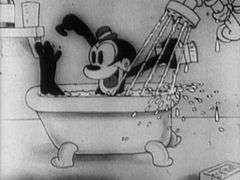Sinkin' in the Bathtub
| Sinkin' in the Bathtub | |
|---|---|
| Looney Tunes (Bosko) series | |
 | |
| Directed by |
Hugh Harman Rudolf Ising |
| Produced by |
Hugh Harman Rudolf Ising |
| Voices by |
Carman Maxwell Rochelle Hudson (both uncredited) |
| Music by | Frank Marsales |
| Animation by |
Isadore Freleng Rollin Hamilton (unc.) Hugh Harman (unc.) Rudolf Ising (unc.) |
| Studio | Leon Schlesinger Productions |
| Distributed by | Warner Bros. Pictures, Inc. |
| Release date(s) | April 19, 1930 (USA) |
| Color process | Black and white |
| Running time | 8 minutes |
| Language | English |
| Preceded by | Bosko, the Talk-Ink Kid |
| Followed by | Congo Jazz |
Sinkin' in the Bathtub is the very first Warner Bros. theatrical cartoon short as well as the very first of the Looney Tunes series.
The short was produced and directed by Hugh Harman and Rudolf Ising, with animation by a very young Friz Freleng. Leon Schlesinger was credited as an associate producer, and the title card also gave credit to the Western Electric apparatus used to create the film.
Plot synopsis
.jpg)
The film opens with Bosko taking a bath while whistling "Singin' in the Bathtub". A series of gags allows him to play the shower spray like a harp, pull up his pants by tugging his hair, and give the limelight to the bathtub itself which stands on its hind feet to perform a dance. (There is a clear shot of a toilet during this scene, and the bathtub tears off sheets of toilet paper during its dance, permissible only in the pre-Hays Code days.)
Once he finds his car, which had left the garage to use the outhouse, Bosko goes to visit his girlfriend Honey, who is showering in front of an open window. "Tiptoe Through the Tulips" plays in the background. A goat eats the flowers he brought, so he serenades her to get her to come out. A saxophone full of bubbles (caused when she dumps a bathtub full of soapy water into Bosko's saxophone due to his butchering of "Tiptoe Through the Tulips") provide a floating cascade of steps for her as she alights from the balcony. "I'm Forever Blowing Bubbles" accompanies this action.
Their country drive presents grave perils for Bosko, with the first obstacle being a stubborn grazing cow. After the cow is pushed out of the way, the indignant cow walks away to the tune of Elgar's "Pomp and Circumstance Marches". The drive continues as the car is at first resistant to go up a steep hill, then speeds out of control while Bosko collides into various objects that create the sounds of ascending and descending C major scales. (Bosko exclaims "mammy" in the original version during this portion of the film.) The sequence ends with the car plunging over a cliff into a lake. Always able to adapt, Bosko continues their date as a boating trip and plays the last refrain (a reprise of "Singin' in the Bathtub") using lilypads as a marimba.
The cartoon ends with Bosko saying the classic line "That's all Folks!"
Production
This cartoon was first theatrically released with the lost Warner Bros./Vitaphone Technicolor film The Song of the Flame.
Made in 1930, this short marked the theatrical debut of Bosko the "Talk-Ink Kid" whom Harman and Ising had created to show to Warner Brothers. Bosko became their first star character, surpassed only much later by Porky Pig and Daffy Duck. Notably, this is the only publicly released Bosko short to feature Bosko's original blackface dialect; he would later adopt a more falsetto voice for later films. Also, this is the first publicly released non-Disney cartoon to have a pre-recorded soundtrack (in addition, "Bosko, the Talk-Ink Kid" had a pre-synched track.)
Some of the animation by Hugh Harman and Rudy Ising was lifted from some of the Oswald the Lucky Rabbit cartoons they made a couple of years earlier.
Release
A clip of this cartoon was seen on a 1990 episode of Pee-Wee's Playhouse. This cartoon exists in its entirety on the Looney Tunes Golden Collection: Volume 3 box set.
References
- Steve Schneider, That's All Folks!: The Art of Warner Bros. Animation (New York: Henry Holt & Co., 1990)
- Jerry Beck and Will Friedwald, Looney Tunes and Merrie Melodies: A Complete Illustrated Guide to the Warner Bros. Cartoons (New York: Henry Holt and Co., 1989)
External links
- Sinkin' in the Bathtub at The Big Cartoon DataBase
- Sinkin' in the Bathtub at the Internet Movie Database